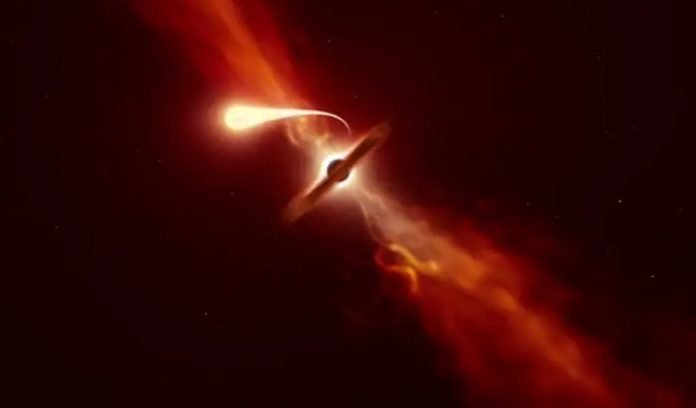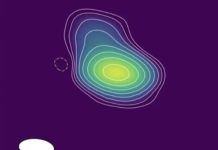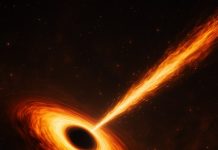
A team of astronomers from renowned universities has made an astounding discovery, witnessing one of the most remarkable “switches on” of a black hole ever observed.
Led by researchers from the University of Birmingham, University College London, and Queen’s University Belfast, this groundbreaking finding sheds light on the mysterious behavior of black holes.
The researchers presented their findings at the National Astronomy Meeting in Cardiff, and their work will be published in the Monthly Notices of the Royal Astronomical Society.
The object of interest, named J221951 or J221951-484240, is an incredibly bright transient astronomical phenomenon, which refers to objects that experience rapid changes in brightness over a short period.
Back in September 2019, Dr. Samantha Oates and her team from the University of Birmingham discovered J221951 while searching for electromagnetic light emitted during a gravitational wave event.
They used the Neil Gehrels Swift Observatory’s Ultra-Violet and Optical Telescope for their observations, hoping to detect a kilonova—a celestial event resulting from the collision of neutron stars or black holes.
Typically, a kilonova starts off appearing blue, then fades and turns more red over several days.
However, J221951 exhibited unusual behavior—it appeared blue but did not change color or fade rapidly like a typical kilonova.
To investigate J221951 further, multiple telescopes were employed, including NASA’s Swift/UVOT and Hubble Space Telescope, the South African Large Telescope, and the ESO (European Southern Observatory) facilities such as the Very Large Telescope and the GROND instrument.
The researchers used these instruments to examine the nature of J221951 and its characteristics.
Through spectroscopic analysis using the Hubble Space Telescope, the researchers ruled out any association between J221951 and the gravitational wave event.
By studying the light spectrum of J221951, Dr. Oates and her team determined that the source is approximately 10 billion light years away, in stark contrast to the gravitational wave signal, which was detected within 0.5 billion light years.
The fact that J221951 shines so brightly from such a vast distance makes it one of the most luminous transient objects ever detected.
The evidence suggests that J221951 came into existence due to the supermassive black hole rapidly consuming surrounding material.
Before its detection, a red galaxy was observed in the same location as J221951, and the black hole’s position aligns with the center of this galaxy, where a massive black hole would typically reside.
J221951 started shining suddenly, approximately 10 months prior to its initial detection, indicating that the black hole began feeding voraciously after a period of relative inactivity. The ultraviolet spectrum shows absorption features consistent with material being expelled outward due to a massive release of energy.
These observations, combined with its immense luminosity, make this event one of the most remarkable instances of a black hole “switching on” ever witnessed.
The research team has proposed two possible mechanisms to explain this extreme feeding behavior of a supermassive black hole. The first theory suggests that it may have occurred due to a tidal disruption event—a star being torn apart as it ventures close to the supermassive black hole at the center of its galaxy.
The second possibility is that it could be the result of an active galactic nucleus transitioning from a dormant to an active state. In this scenario, J221951 would serve as evidence that a previously dormant black hole at the core of its host galaxy has begun consuming material from an accretion disk.
Dr. Matt Nicholl, a member of the research team from Queen’s University Belfast, highlighted how our understanding of the behavior of supermassive black holes has significantly expanded in recent years.
He mentioned discoveries such as stars being torn apart and black holes with highly variable luminosities. J221951 represents an extreme example of a black hole surprising scientists.
By monitoring J221951 continuously, the researchers aim to calculate the total energy release, which could help determine whether this event is a tidal disruption of a star caused by a fast-spinning black hole or a novel type of active galactic nucleus switch-on.
Another team member, Dr. N. Paul Kuin from University College London’s Mullard Space Science Laboratory, emphasized the importance of space-based ultraviolet spectrograph capabilities in making the key discovery that ruled out a Galactic origin for J221951.
Dr. Kuin stated the significance of maintaining such capabilities for future astronomical studies.
Dr. Samantha Oates further added that ongoing monitoring of J221951 over the next few months to years will provide crucial insights to differentiate between the tidal disruption event and active galactic nucleus scenarios.
If J221951 is associated with an active galactic nucleus, scientists would expect it to cease fading and possibly increase in brightness.
On the other hand, if it is a tidal disruption event, the object is likely to continue fading. Continued observations will be vital in unraveling the mysteries behind this extraordinary phenomenon.
Follow us on Twitter for more articles about this topic.



